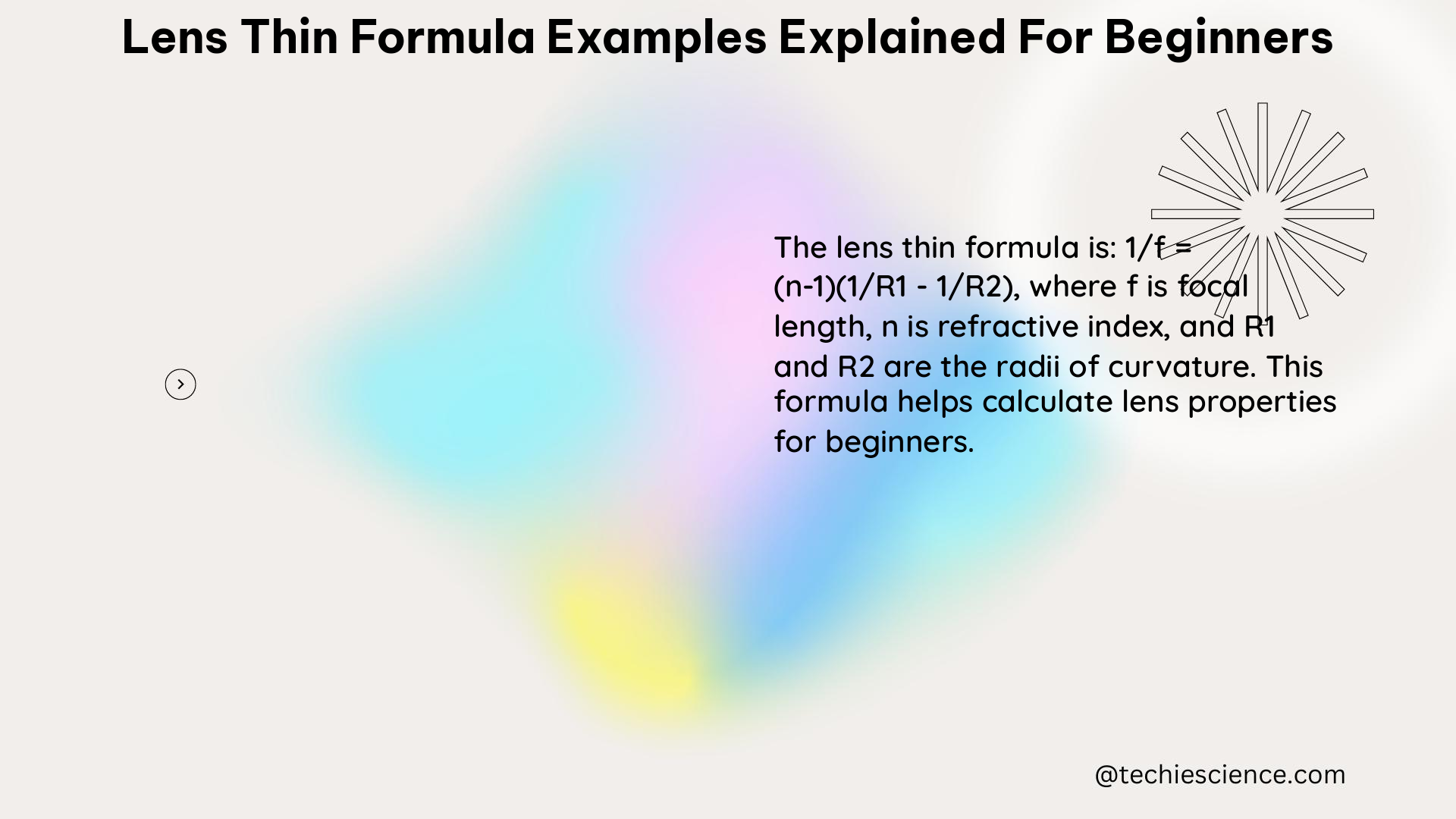The thin lens formula, expressed as 1/f = 1/do + 1/di, is a fundamental equation in geometric optics that relates the focal length (f) of a thin lens to the object distance (do) and the image distance (di). This formula allows us to calculate the image distance or the magnification of an image formed by a thin lens, given the object distance and the focal length.
Theorem: The Lens Maker’s Equation
The thin lens formula is derived from the lens maker’s equation, which is a more general equation that applies to thick lenses as well. The lens maker’s equation is expressed as:
1/f = (n-1)(1/R1 – 1/R2)
Where:
– f is the focal length of the lens
– n is the refractive index of the lens material
– R1 and R2 are the radii of curvature of the two surfaces of the lens
The thin lens formula is a simplified version of the lens maker’s equation that assumes the lens is thin compared to the distances involved.
Physics Formula: The Thin Lens Equation

The thin lens formula is expressed as:
1/f = 1/do + 1/di
Where:
– f is the focal length of the lens
– do is the object distance
– di is the image distance
Physics Examples: Applying the Thin Lens Formula
The thin lens formula can be applied to a variety of situations involving thin lenses, such as:
- Calculating the image distance and magnification of an object placed in front of a convex lens.
- Calculating the image distance and magnification of an object placed in front of a concave lens.
- Determining the focal length of a lens given the object and image distances.
Physics Numerical Problems
Here are some sample numerical problems that can be solved using the thin lens formula:
- A convex lens has a focal length of 20 cm. An object is placed 30 cm in front of the lens. Calculate the image distance and magnification.
- A concave lens has a focal length of -15 cm. An object is placed 20 cm in front of the lens. Calculate the image distance and magnification.
- A thin lens has a focal length of 10 cm. An object is placed 15 cm in front of the lens. Calculate the image distance and magnification.
- A thin lens has a focal length of 20 cm. An object is placed 25 cm in front of the lens. Calculate the image distance and magnification.
Figures
The following figures illustrate the concept of image formation by a thin lens:

Figure 1: Image formation by a convex lens

Figure 2: Image formation by a concave lens
Data Points, Values, Measurements
The thin lens formula involves three variables: the focal length (f), the object distance (do), and the image distance (di). These variables can be measured in units of length, such as centimeters or meters. The sign conventions for these variables are as follows:
- The focal length (f) is positive for a convex lens and negative for a concave lens.
- The object distance (do) is positive if the object is in front of the lens and negative if it is behind the lens.
- The image distance (di) is positive if the image is real and behind the lens, and negative if the image is virtual and in front of the lens.
Theoretical Explanation
The thin lens formula is based on the principle of reversibility of light rays, which states that the path of light rays is reversible. This means that if we know the path of light rays from an object to an image, we can reverse the direction of the rays and determine the path of the rays from the image to the object.
The thin lens formula is derived from the lens maker’s equation, which is a more general equation that applies to thick lenses as well. The thin lens formula is a simplified version of the lens maker’s equation that assumes the lens is thin compared to the distances involved.
The thin lens formula can be used to calculate the image distance and magnification of an object placed in front of a thin lens. The magnification (M) is defined as the ratio of the image height (hi) to the object height (ho), and can be expressed as M = -di/do.
References
- Physics Classroom: The Mathematics of Lenses
https://www.physicsclassroom.com/class/refrn/Lesson-5/The-Mathematics-of-Lenses - Arbor Scientific: Modeling with the “Thin Lens” Equation
https://www.arborsci.com/blogs/cool/modeling-the-thin-lens-equation - Physics LibreTexts: Thin Lenses
https://phys.libretexts.org/Bookshelves/University_Physics/University_Physics_%28OpenStax%29/University_Physics_III_-_Optics_and_Modern_Physics_%28OpenStax%29/02:_Geometric_Optics_and_Image_Formation/2.05:_Thin_Lenses - Khan Academy: Thin Lens Equation and Problem Solving
https://www.khanacademy.org/science/physics/geometric-optics/lenses/v/thin-lens-equation-and-problem-solving - Study.com: Thin Lens Equation | Formula, Problems & Examples
https://study.com/academy/lesson/thin-lens-equation-examples-questions.html

The lambdageeks.com Core SME Team is a group of experienced subject matter experts from diverse scientific and technical fields including Physics, Chemistry, Technology,Electronics & Electrical Engineering, Automotive, Mechanical Engineering. Our team collaborates to create high-quality, well-researched articles on a wide range of science and technology topics for the lambdageeks.com website.
All Our Senior SME are having more than 7 Years of experience in the respective fields . They are either Working Industry Professionals or assocaited With different Universities. Refer Our Authors Page to get to know About our Core SMEs.